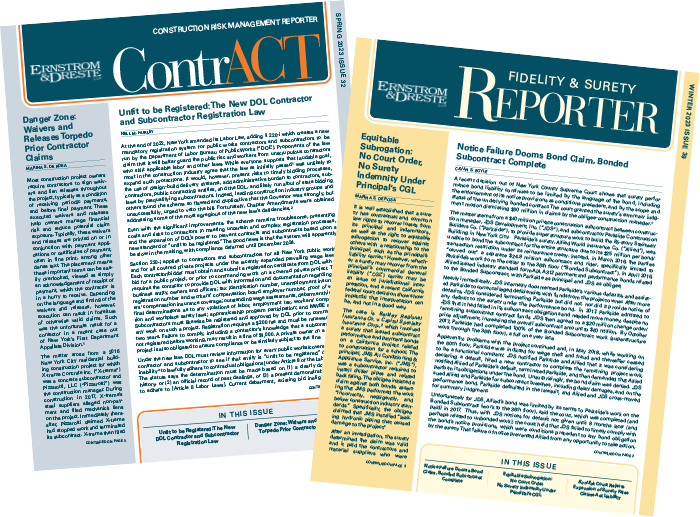Article by: Nell M. Hurley
A 2023 court decision highlights the dangers of a contractor’s assumptions about work it is required to perform, especially in the face of contract exculpatory clauses that place the risk for that assumption directly on the contractor.1
The matter stems from a New York State Power Authority (“NYPA”) construction contract with B.V.R Construction Company, Inc. (“BVR”), which then subcontracted the concrete demolition work for the project to Penn Hydro, Inc. (“Penn Hydro”). There was no information about the strength or “hardness” of the concrete contained in the prime contract or represented in project plans and specifications. Penn Hydro’s written proposal, which was ultimately attached as an exhibit to the unit price subcontract, stated that its pricing was “based on” removal of approximately 4000 psi2 concrete.
Soon after starting the demolition work, Penn Hydro learned that the concrete’s hardness varied from place to place and was much more difficult to demolish than expected. This resulted in additional costs for manpower and equipment, and the work proceeded very slowly. Thereafter, Penn Hydro asked for, and BVR obtained, test boring samples showing the psi of the 5 concrete samples to be 9720, 5500, 5400, 8030, and 8490, much higher than either party likely expected.
Penn Hydro sought unsuccessfully to recover its additional costs from BVR, ultimately filing the lawsuit. BVR denied Penn Hydro’s claim and moved for summary judgment relying on subcontract language it said placed responsibility for the higher psi concrete on Penn Hydro. The motion court ruled for Penn Hydro and denied BVR’s motion. On appeal, however, the lower court’s decision was reversed, and Penn Hydro’s breach of contract action for additional compensation was dismissed.
While the parties agreed that the terms of the subcontract governed the claim, the court concluded that Penn Hydro’s pricing proposal “assumption” (work “based on” 4000 psi concrete) was not a condition of the subcontract. The court reasoned that because the subcontract failed to provide any “cognizable formula” by which a different price could be ascertained for removal of harder concrete, the values in the proposal established a set price for the work, not contingent on psi strength.
The court then determined that the subcontract’s “investigations clause” (aptly rebranded by BVR as an “assumption of risk” clause) placed the risk of the harder concrete on Penn Hydro. Pursuant to that provision, decided the court, Penn Hydro accepted responsibility for inspecting “the conditions that could affect the [s]ubcontract [w]ork at the [p]roject site” and was properly charged with the knowledge such an inspection would have revealed, including concrete psi higher than anticipated. Thus, the decision means those costs must be borne by Penn Hydro.
Significant to this outcome may have been the lack of representations by the NYPA or BVR regarding concrete psi. New York law may permit recovery based upon a “qualitative change” in the contract work in certain circumstances, but typically requires that some significant contract term has changed. Here, the psi strength “term” was nothing more than an assumption by Penn Hydro, according to this decision.
There are actions a contractor can take to protect itself. Understand that “investigations clauses” are designed to transfer risk to the contractor (or subcontractor). Be sure to fully review all important assumptions upon which contract work is based. In the case here, even without test borings, a substantial disparity in concrete strength likely could have been detected before the subcontract was signed. In preparing pricing where an important variable is unknown, but must be assumed in the bid/proposal, set forth alternate parameters that permit, or even require, an adjustment if that assumption turns out to be erroneous. And finally, remember that a mere staple attaching a proposal to the subcontract as an exhibit does not automatically make all its terms a part of the contract – for that you need language in the contract that expressly incorporates the exhibit and its specific terms.
- Penn Hyrdro, Inc. v. B.V.R. Constr. Co., Inc., 218 AD3d 1253 (4th Dept 2023).
- Psi stands for pounds per square inch, a standard measure of hardness for concrete.




